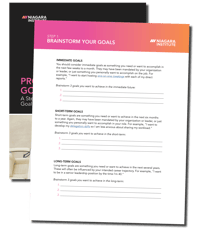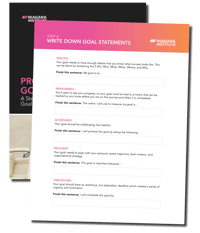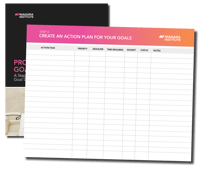Professional Goals Workbook:
A Step-by-Step Guide and Goal Setting Worksheets
How do you ensure you are getting where you want to go or achieving what you want to achieve? You do so by setting professional goals, creating an action plan to make it happen, and then doing the work to see it through. To help you do so, this goal-setting workbook outlines a four-step process and includes practical worksheets for you to complete.
Download the PDF (English & French Included)
Introduction
Most people intrinsically understand the value of goal setting. How will you know where you’re going without a destination in mind? The importance of setting goals for achieving personal and professional achievement is well proven as it has been found that people who have clearly defined goals are 10x more successful than those who do not.
By their very nature, goals provide clarity. At work and in life, you are constantly bombarded with decisions that move you closer to where you want to be or further away. Having concrete goals help you make focused, right choices and push out the alternatives.
Goals act as a map to where you want to land. If they’re vague such as “do great work,” you can guarantee you won’t end up where you want to be. Goal setting is envisioning your desired outcome, writing it down, formulating a plan of action, and last but not least, putting in the hard work to make it a reality.
We’ve created this toolkit to provide you with the resources to turn an ambition in your mind, into a concrete, actionable road map to achieving your professional goals. Use this four-step process, which includes goal worksheets, to simplify the goal setting process.
Table of Contents
What Are the Benefits of Goal Setting?
If you’re still not convinced that goal setting is worth pursuing, we hope these eye-opening statistics change your mind.
- Goal Setting Improves One’s Likelihood of Success - In one survey, 83% of respondents did not have goals. But of the 14% who did, even if they were unwritten, they were found to be 10 times more successful. (Harvard Business Review)
- Goal Setting Improves Employee Engagement - 72% of millennial employees were found to be engaged as a result of their direct manager helping them establish performance goals. (Gallup)
- Goal Setting Improves Performance and Morale - Formal, structured goal setting processes lead to improved workplace optimism, higher levels of individual performance, and higher levels of employee engagement. (Journal of Industrial Management & Data Systems)
- Goal Setting Improves One’s Loyalty to a Company - Tying employee goals to both employees’ professional development and organizational goals can increase employees’ commitment to the company. (Deloitte)
Step 1: Brainstorm Your Goals
If you want the benefits of goal setting to be realized in your own life at work, then the first step in the goal setting process is to take time to evaluate where you are today to develop a vision of what you want to accomplish in the immediate, short-term, and the long-run. What do you want to achieve in the next month? Next year? Next 10 years? What would give you a sense of purpose that would make all the ups and downs at work worthwhile? What would contribute to your success and even the success of your team or organization that you would be proud of?
Typically, the goals you brainstorm will be one of these three types of goals: immediate, short-term, or long-term. Using the worksheet provided below, place the goals you have brainstormed into these three categories without worrying if they are undefined. We will use the SMART goals formula in the next section to do that.
Immediate Goals
You should consider immediate goals as something you need or want to accomplish in the next few weeks to a month. They may have been mandated by your organization or leader, or just something you personally want to accomplish on the job. For example, “I want to start hosting one-on-one meetings with each of my direct reports.”
Short-Term Goals
Short-term goals are something you need or want to achieve in the next six months to a year. Again, they may have been mandated by your organization or leader, or just something you personally want to accomplish in your role. For example, “I want to develop my delegation skills so I am less anxious about sharing my workload.”
Long-Term Goals
Long-term goals are something you need or want to achieve in the next several years. These will often be influenced by your intended career trajectory. For example, “I want to be in a senior leadership position by the time I’m 40.”
Step 2: Write Down Goal Statements
In a study conducted by Dr. Gail Matthews, a psychology professor at Dominican University in California, it was found that you become 42% more likely to achieve your goals, simply by writing them down. This is not a one-off finding either; a separate study found that by vividly describing your goals in written form, you may be up to 1.4 times more likely to succeed than those who don’t.
If you’re curious as to why this is, there are many articles written by neuroscientists and psychologists, but this explanation from a Bustle article should do the trick: “The right hemisphere of our brain is the imaginative side, while the left is the literal side. If you only think about your goals, you're only really relying on the right hemisphere. By writing them down, however, you involve the left hemisphere. With the two working together on your goal, you bring your whole body in on it.”
In light of this, the following section is designed to help you formalize the rough goals you brainstormed in the previous step into written goal statements using the SMART goals technique, first discussed in the article, “There’s a S.M.A.R.T. way to write management goals and objectives.” If you are unfamiliar with the concept, SMART stands for specific, measurable, achievable, relevant, and time-bound and is used to ensure any goal, whether personal or professional, short-term or long-term, is thoroughly thought out and well-defined. By writing goal statements in this way, you are less likely to set goals for yourself that are too ambitious or ambiguous, and more likely to set goals that are challenging, yet achievable.
-
Specific: Your goal needs to have enough details that you know what success looks like. This can be done by answering the 5 W’s: Who, What, When, Where, and Why.
-
Measurable: You’ll want to see your progress, so your goal must be tied to a metric that can be tracked so you know where you are on the journey and when it is completed.
-
Achievable: Your goal should be challenging, but realistic.
-
Relevant: Your goal needs to align with your personal career trajectory, team mission, and organizational strategy.
-
Time-Bound: Your goal should have an ambitious, but attainable, deadline which creates a sense of urgency and motivation.
At this point, download our SMART goals worksheet using the form below as it will help you formalize written goal statements for each of the goals you listed in the last section.
Step 3: Create an Action Plan for Your Goals
The next step in the goal setting process is to create an action plan. To do this, you will need to determine the steps that will need to be taken to eventually achieve the goal you have set. From there you’ll want to map the steps you have come up with against a timeline. At this point, you should also consider the resources you need to achieve the goal, which could include the people that will help you, any funding needed for technology, new skills that will need to be developed, as well as any potential obstacles you can foresee.
While it may be tempting to skip this step and jump right into it, the time you spend formulating a strong action plan will be worthwhile, as you will begin your journey towards achieving your goal feeling more prepared, organized, accountable, and motivated. All of which is essential if you want to be as successful as possible.
Start by answering the following questions and then download the action plan template using the form below.
- What skills do you need to achieve your goal? Will you need training?
- Who can help you achieve your goal? What resources will you need?
- What funding do you need to achieve your goal?
- What potential problems, challenges, or obstacles might you encounter and should therefore monitor?
- What milestones will you celebrate along the way and what can you do to celebrate?
Step 4: Evaluate Progress Using a Goal Tracker Template
At this point, you should feel thoroughly prepared to put your action plan into place and make your defined goal a reality. As you jump into the tactics, remember that it is important to pause and reflect regularly throughout the process. By doing so, you can confirm you are on the track you set for yourself, update your action plan or goal accordingly, problem solve, and seek support as needed. How often you do so will depend on the type of goal you have identified and the timeline you outlined. For example, if your goal is an immediate or short-term goal, it might be best to evaluate your progress at least once a week, whereas a long-term goal you may choose to evaluate quarterly or annually.
If you’re not sure what it looks like to evaluate your progress towards a goal, we suggest downloading the goal tracker template using the form below to help you make the most of these set checkpoints.
Next Steps: Make Your Goals a Reality With Niagara Institute
Goal setting is a process that demands time, intentionality, and determination to be truly successful. Unfortunately, for many people, this process may have been too vague and undefined in the past to truly invest or believe in it. For that reason, it is our hope in building these goal setting worksheets and templates, that you now feel you have a clear understanding of what it takes to take a goal from ideation to action to completion.
Of course, as you work through this toolkit and formulate your goals and action plan, you may identify a need for additional professional development and training. In which case, the Niagara Institute is an ideal first place to turn. With business acumen training programs, leadership development training programs, and professional coaches, you will be sure to find all the resources you need, when you need them, to ensure all your goals become a reality.




